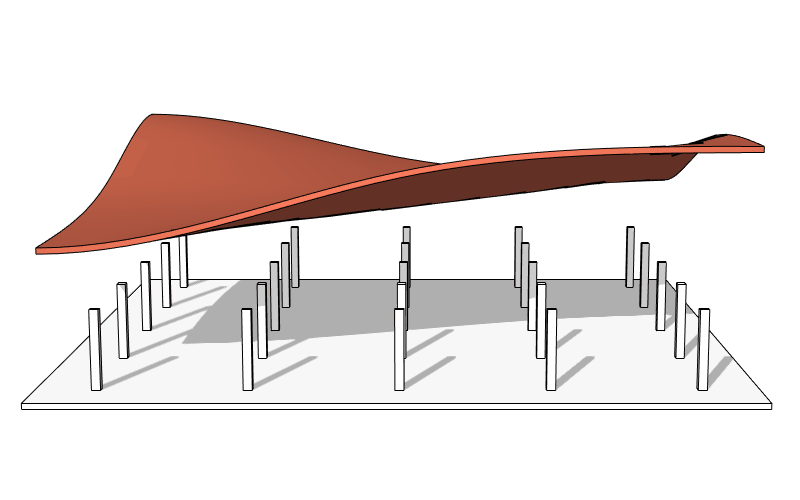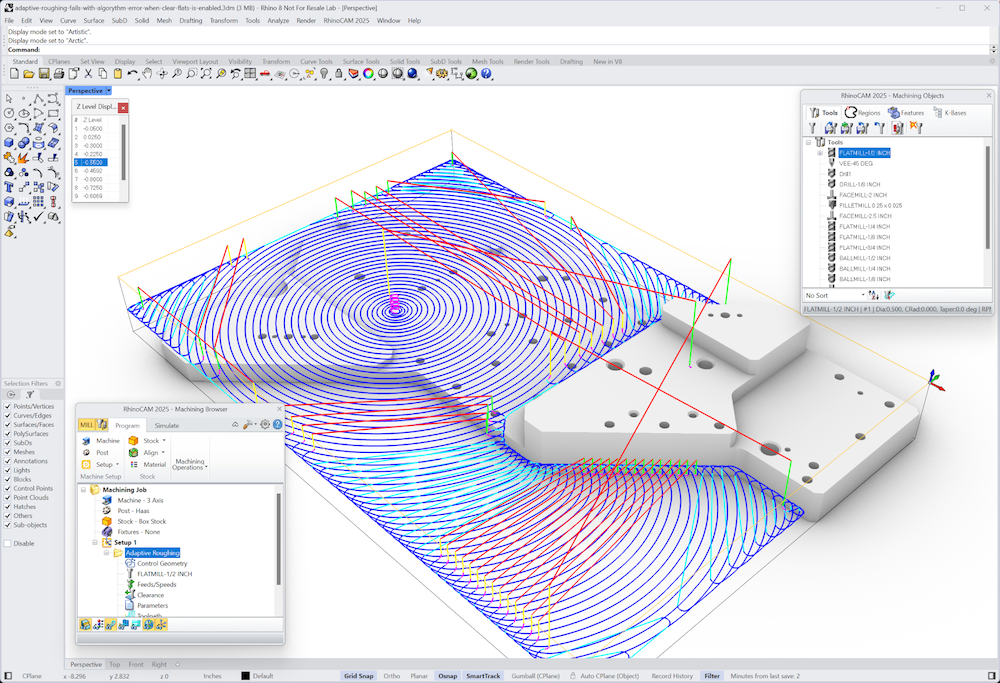Your Cart is Empty
Customer Testimonials
-
"Great customer service. The folks at Novedge were super helpful in navigating a somewhat complicated order including software upgrades and serial numbers in various stages of inactivity. They were friendly and helpful throughout the process.."
Ruben Ruckmark
"Quick & very helpful. We have been using Novedge for years and are very happy with their quick service when we need to make a purchase and excellent support resolving any issues."
Will Woodson
"Scott is the best. He reminds me about subscriptions dates, guides me in the correct direction for updates. He always responds promptly to me. He is literally the reason I continue to work with Novedge and will do so in the future."
Edward Mchugh
"Calvin Lok is “the man”. After my purchase of Sketchup 2021, he called me and provided step-by-step instructions to ease me through difficulties I was having with the setup of my new software."
Mike Borzage
Novedge Webinar #113: Maxwell Render Suite V3 & SketchUp for Architectural Design – Q&A with Francois Verhoeven
May 14, 2014 10 min read
Do you use SketchUp for your architectural designs? Have you thought of adding Maxwell Render to your workflow? We have a webinar to show you how to make the best of Maxwell Render's plugin for SketchUp 2014. Check it out and read the answers to all the questions Francois Verhoeven couldn't get to during the live show.
Q: Do you have a good resource for MXS reference components?
A: From the above webinar minute 59: I mostly use Design Connected. They have really great models but also Evermotion is good for MXS prepared components for trees.
There are a lot of models available on the market if you are on a Mac. If you´re on a Mac you can´t use 3ds Max so you have to have some kind of format importer to get your models into Maxwell Studio. I didn´t get to show how Maxwell Studio works but Maxwell Studio is a standalone application which comes with Maxwell Render Suite. Maxwell Studio has a lot more import facilities than SketchUp so what we usually do is get components from all over the web and import them straight into Maxwell Studio. From there we adjust these components to our liking and import them as reference components into SketchUp. If we can´t import in Maxwell Studio we will try to import it in either Vectorworks or into MODO or in Blender or one of those available Mac applications.
There aren´t as many Maxwell components as you will find for 3ds Max but most of those components that are available for other packages can be converted one way or another by using other CAD applications or just straight into [Maxwell] Studio. In saying that, we have always been able to convert a model for use in SketchUp and, in fact, you don´t have to use the actual geometry in SketchUp – it gives you a very wide variety of components available.
In the past, before the SketchUp plugin was developed, for reference components we were stuck with components that imported into SketchUp and some of those (like Evermotion trees) once imported into SketchUp were completely unusable because of the amount of geometry. SketchUp couldn´t handle all that geometry.
Once you´ve found your way of converting components from the web into Maxwell MXS format (by using something like an application/Studio to convert your components), most components, symbols or geometry from a 3D warehouse will work fine.
I’m hoping that when Maxwell gets even more popular among SketchUp users that there will be a really good library of MXS components. At this moment, as an architect, we have most of the components we really need. In archviz, especially for an architecture studio, we need cars, trees, grass, people and furniture which we get from Design Connected or other model manufacturers on the web. Sometimes it seems that you really need an enormous array of symbols and components but to be honest that´s really not true. You just need a good set and you can use those for many different kinds of designs of buildings, houses and so on. I would advise anyone that´s looking for a component to really work out what you generally need and keep looking for them on the web and build your own library. Then try to keep everything into Studio’s MXS format so your SketchUp files are light and easy to handle.
On a related note, though it has always been possible to create MXS files for referencing from within SketchUp when using the Maxwell Render Suite, plugin version 3.0.11 introduces this ability also for the Standalone plugin, provided it is licensed, and running in SketchUp Pro. For information on using and creating MXS files for referencing, click here.
Q: Do you have a workflow for creating reference components?
A: Please see the previous question as well as these helpful links:
- Productivity Tips for Maxwell Render when used with SketchUp – from the Plugin Developer Himself!
Q: Can you discuss how you blend realistic and sketch qualities in the same rendering?
A: This is done by overlaying a SketchUp "sketchy" rendering over a Maxwell one, using Photoshop or similar. This is not specific to SketchUp — people use the same technique with many other of the supported host applications. All that is required is a perspective match between the host application viewport and the Maxwell camera.
Q: What kind of light did you use in the interior of the building you did? How did you set up your lights in SketchUp?
A: To best answer this question, please see this section in the support center.
Q: How do you suggest to create multilayered materials in Maxwell Render? I saw you have one material with 3 Addictive layers …
A: Please see these sections in the support center:
Note that you need MXED (Maxwell Render Suite, in other words) to build the type of material being referred to in this question.
Q: Is this a USA product or not?
A: Maxwell Render is a product of Next Limit Technologies, a Spanish company founded in 1998. Novedge is an authorized US reseller of all NextLimit products.
Q: Francois, do you use IES or emitter lighting?
A: Please see these sections in the support center:
SketchUp – Setting Up Lighting
In the webinar I also used Image Based HDRI enviromental lighting.
Q: For that speed, what hard specs are you using? Are you on a single workstation or …?
A: Taken from the webinar above, minute 56: “I’m using a single workstation, new Mac Pro. 4 core 3.7 GHz with about 15 GB of RAM. It’s actually a very basic new Mac Pro. I own a Mac Pro 8 core from 2008 and I´d say it´s about the same speed.”
Q: At what point should we stop rendering in Sketchup and render on Maxwell instead?
A: With the Standalone plugin, Maxwell Fire is both used for scene setup, and for rendering of final images. When the Maxwell for SketchUp standalone plugin is licensed, you can choose whether Maxwell Fire uses its Draft or Production render engine. Actual output resolution and the render engine used are set in the Maxwell Fire Settings window (limited to 800×800 unlicensed version, 1920×1080 licensed version).
With Maxwell Render Suite, while Maxwell Fire can be used to render final images, its primary purpose is to provide real-time feedback during scene setup. It is assumed that an MXS file will subsequently be written, and rendered in Maxwell Render (no resolution restrictions), so you´ll be rendering outside SketchUp allowing you to keep working in SketchUp. There is also a non-zero overhead associated with running within another application's process, so also in terms of performance, it is recommended to always render final images in Maxwell Render.
Q: I noticed the blog on Maxwell Render had very little support than other plugins like Maya, for example. Where else would you recommend for learning?
A: Maxwell's suport center has a good amount of documentation on Maya and all the other plugins supported. Here's the link.
Q: Does MW Fire allow us to crop just a segment of the scene (zoomed in) to speed up render preview in fire?
A: No, Maxwell Fire always renders using the field of view of the SketchUp camera. However, it does allow rendering the camera's view at arbitrarily-small actual resolution (set in Maxwell FIRE Settings) precisely for the purpose of speeding up the preview. The rendered image can be switched between being shown full-size, or being scaled to fit the size of the Maxwell FIRE window. This reduced resolution applies only to the Maxwell FIRE window, and does not affect what will be sent to Maxwell Render when the scene is actually exported for rendering.
Q: What would you say is the main reason for using the full Render Suite as opposed to just the plugin? I'm getting good results from the plugin but am a bit frustrated by the limit on the output resolution. It's a big leap in terms of price, so is it worth it?
A: Taken from webinar minute 1:04 – To be honest I haven´t used the Maxwell for SketchUp standalone version as I always work with the Suite. From what I know, the difference between the two is really that with the Suite you have more use of the plugins and an unrestricted resolution limit. With the Suite I also like to use network rendering and to be able to use Maxwell Studio.
The use of Maxwell Studio is important when having large amounts of geometry. SketchUp is a great program but what you can´t do is handle large amounts of geometry like 50 trees, 10 cars and half a city block. Basically it´s impossible to do that in SketchUp. What we do is we model those large projects into several SketchUp files and bring those into Studio (which belongs to the Suite) and then we set up the combined SketchUp models in Studio which can handle any amount of geometry that is usually required in any archviz situation.
If you ask me if it’s worth your while to get Maxwell Render Suite, I certainly would recommend that. I can imagine if you run a really small architectural office and your clients aren´t as demanding as a larger firm might have, you might think twice about that. But to be truly honest, I would never go back to the Maxwell for SketchUp standalone version simply because it´s too limited for me. I’m referring to the extras Maxwell Render Suite gives me that I´ve previously mentioned – like Maxwell Studio, the higher resolution and so on. Once you start using Maxwell a lot alongside SketchUp, I can’t imagine why people wouldn’t get into the Suite. I would think that Maxwell Render Suite will be your next upgrade once you do more work with it.
The reason why people probably would restrict themselves to Maxwell for SketchUp standalone is just to have a look at it, to see how Maxwell performs for them, and to see if it´s the right choice. But once you feel that you are comfortable with Maxwell and the way it works and the quality you get (there´s a lot more to be said about the quality), Maxwell Render Suite will be something you will enjoy a lot with SketchUp.
Other advantages of Maxwell Render Suite are that you can use a lot of other programs to render your models in Maxwell. We have a license for MODO, Blender and some other packages and the nice thing is that we all render our images in the same render application which makes things easier. We are able to predict the outcome of the render much better with one single render application for several modelers – which without the Suite you would also have to learn how to render in different applications. Having said that I can imagine for some people it can be costly if your clients don´t pay for it. That could be a reason not to expand your skills to the Render Suite.
Q: What is a referenced component? Is this a SketchUp feature or a Maxwell Render feature?
A: Please see the following links:
- Productivity Tips for Maxwell Render when used with SketchUp – from the Plugin Developer Himself!
Q: Francois… Is there a path to go from Vectorworks to Maxwell Render?
A: Maxwell doesn't have a direct plugin for Vectorworks but depending on the file formats from Vectorworks, you may be able to use the Maxwell Studio workflow just fine.
Q: We have created MXS references ourselves using SketchUp components. Have you found a resource for "pre-made" MXS reference such as trees, cars, interior entourage?
A: Please see first question.
Q: Is Maxwell significantly faster when network rendering assuming a good rack of servers?
A: Maxwell Render’s networking capabilities are very powerful (more computers equal more speed in a very linear way), and very flexible – networking is multi-platform allowing a mixture of Windows, Mac and Linux systems to be connected together.
Q: Is it possible to change the color of the fog?
A: Yes, since a volumetric uses the material assigned to its Group in SketchUp.
Q: How do you use reference components?
A: Please see the first question.
Q: How do you enter a Maxwell instance into a skp file? Are they components / How do you make them?
A: All but the first instance of a given Component will be exported to Maxwell as a Maxwell instance. This is the default behavior, though it is also possible to disable the export of instances. That is not recommended, though, in the interest of minimizing memory usage.
- Productivity Tips for Maxwell Render when used with SketchUp – from the Plugin Developer Himself!
Q: I use Maxwell plug in for rendering exhibition stands in SketchUp. Currently I add in lighting as emitters: would these still work in the multi light function? Generally they are hidden panels with an emitter material assigned to them, for example flood lights. Often it can take time to adjust and get it just right… Would Multilight work on these materials, or do they have to be in a special format?
A: That should work just fine for what you describe. More info on setting it up here. Please note that the Multilight feature is unique to Maxwell Render Suite. It is not included in the standalone Maxwell for SketchUp.
Q: Are there limits, e.g. scale / file size / or things to avoid and perhaps suggest some "Best Practice Habits"? Can one assign extra RAM to it directly like in Photoshop? Would be great if you could share some resource links.
A: The only limit has to do with memory, as it relates to rendering directly within SketchUp (i.e. in Maxwell FIRE), where up to a maximum of 4GB is able to be used. Regarding Photoshop, I believe the question relates to a so-called "Let Photoshop Use" setting, which limits Photoshop to using some percentage less than 100% of the available memory. That is to say, it does not allow for assigning extra memory, but only for controlling the amount that goes purposefully unused. Maxwell provides no such setting or artificial limitation. You can read more here.
Q: Is it possible to create a walk-through on SketchUp with the Hi-Definition of Maxwell? If yes, can you give a brief tutorial?
A: No, there is no animation support in the plugin. With Maxwell Render Suite, it is possible to export several cameras (i.e. Scenes in SketchUp) into a single MXS, and then render them as an animation using a Python script.
Did you enjoy our latest webinar? To register for future Novedge Webinars, click here. To get your own copy of Maxwell Render or the standlone plugin for SketchUp, visit our website at novedge.com.
Related articles
Also in NOVEDGE Blog

Enhance Your Designs with VisualARQ 3: Effortless Geometry Extensions for Walls and Columns
April 30, 2025 8 min read
Read More
MecSoft Unveils RhinoCAM 2025 and VisualCAD/CAM 2025 with Enhanced Features
March 08, 2025 5 min read
Read MoreSubscribe
Sign up to get the latest on sales, new releases and more …






